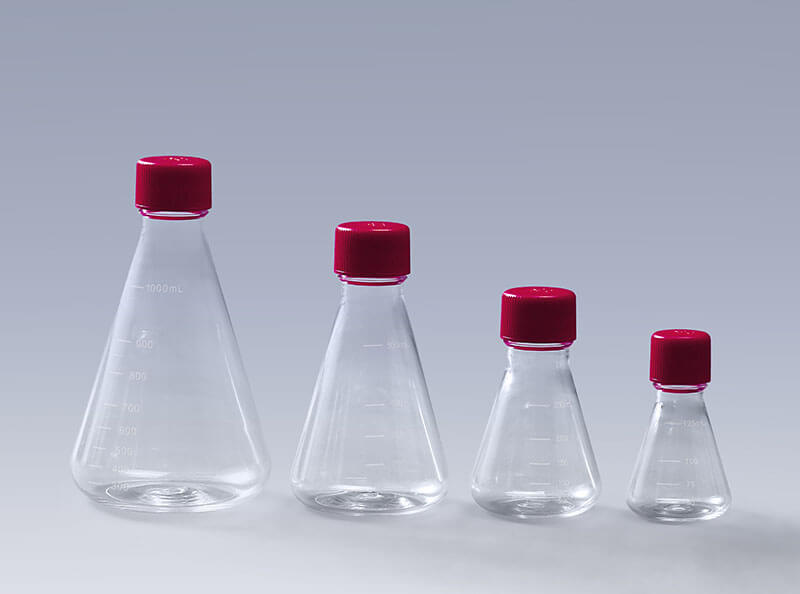Liquid strains are cultivated in liquid media and are favored for their short production cycles, uniform growth stages, ease of inoculation, and suitability for industrial production. Erlenmeyer Flasks are essential consumables in this process, and the following key points should be considered during cultivation:
1. Medium Preparation
Prepare the culture medium by weighing the various components according to the recipe, dissolving them in water, and distributing them into Erlenmeyer Flasks. Typically, a 250–300 mL Erlenmeyer Flask is filled with 50 mL of culture medium, while a 500 mL flask contains 100 mL. Seal the flasks with cotton plugs and wrap them in newspaper, or use an 8-layer gauze square (8 cm x 8 cm) as a cork, secured with kraft paper.
2. Sterilization
The sterilization process usually involves high-pressure sterilization at 121°C for 30 minutes. After sterilization, cool the flasks to around 30°C before placing them in a sterile room or inoculation chamber for later use.
3. Inoculation
Following sterile operating procedures, introduce a 2–3 cm² piece of slant culture into each flask. Each slant can inoculate 4–5 flasks. It is preferable for the inoculum to contain a bit of culture medium to allow it to float on the surface. After inoculation, cover the flask opening with the gauze used for sealing and tie it securely with string.

4. Cultivation
The inoculated flasks can be placed on a shaker for cultivation or kept at a constant temperature of 24–26°C for 48 hours. After the mycelium has extended into the culture medium, switch to shaking cultivation. For reciprocating shakers, the oscillation frequency should be 80–120 rpm, while for rotary shakers, it should be 150–220 rpm. Cultivation for 3–4 days is usually sufficient. At the end of the cultivation period, the culture medium will show different colors depending on the strain: for example, the liquid for oyster mushrooms and enoki mushrooms will be light yellow, while shiitake and lion's mane mushrooms will yield a reddish-brown liquid with a mushroom aroma. The liquid should be free of contaminants, with mycelial dry weight reaching 10 g/L and mycelial ball diameters between 1–2 mm before it can be used for production or further expansion.
5. Production of Secondary Liquid Strains
The preparation of the secondary liquid strain medium follows the same principles as for primary strains, but the containers should be larger, holding no more than 3,500 mL. After sterilization and cooling, inoculate 5 L Erlenmeyer Flasks with 5%–10% of the previously fermented primary liquid strain and place them on a shaker with a slower rotation speed. After a certain period of shaking cultivation, you will achieve an evenly distributed mycelium ball and a clear, transparent liquid culture.
In summary, by following the outlined methods for cultivating liquid strains in Erlenmeyer Flasks and controlling factors such as temperature and shaker oscillation frequency, you can ensure effective cultivation results.
The FAI climbed 5.9 percent year-on-year in the first 11 months of 2018, quickening from the 5.7-percent growth in Jan-Oct, the National Bureau of Statistics (NBS) said Friday in an online statement.
The key indicator of investment, dubbed a major growth driver, hit the bottom in August and has since started to rebound steadily.
In the face of emerging economic challenges home and abroad, China has stepped up efforts to stabilize investment, in particular rolling out measures to motivate private investors and channel funds into infrastructure.
Friday's data showed private investment, accounting for more than 60 percent of the total FAI, expanded by a brisk 8.7 percent.
NBS spokesperson Mao Shengyong said funds into weak economic links registered rapid increases as investment in environmental protection and agriculture jumped 42 percent and 12.5 percent respectively, much faster than the average.
In breakdown, investment in high-tech and equipment manufacturing remained vigorous with 16.1-percent and 11.6-percent increases respectively in the first 11 months. Infrastructure investment gained 3.7 percent, staying flat. Investment in property development rose 9.7 percent, also unchanged.
 English
English


















































